Welcome to FISH FOOD TIMES
Jun. 2017 issue No.162

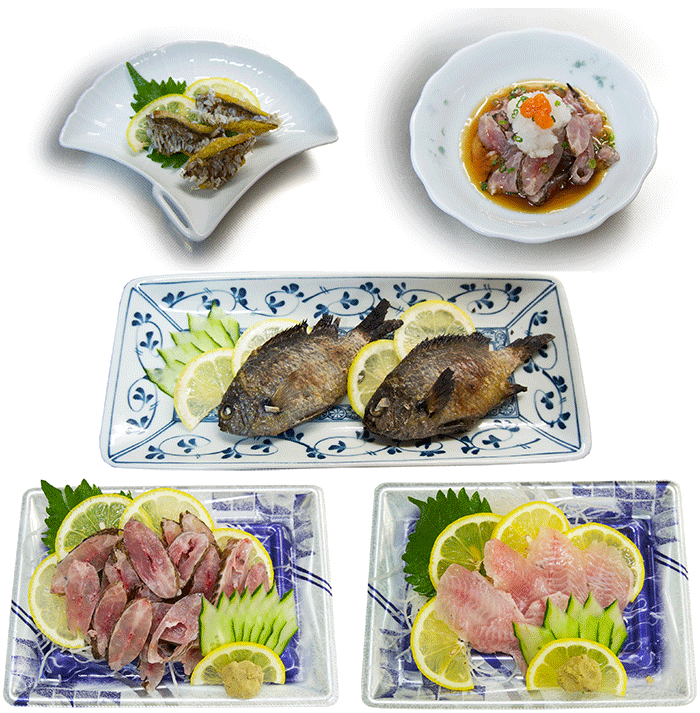
Damselfish cuisine
Damselfish tastes good in early summer
The name of the fish called Abutecamo is the name of the Fukuoka district of damselfish.
I was in Fukuoka City was to start the work of the fish. When I first touched a fish named Abtecamo decades ago, not only the uniqueness of the name, but also how to eat this fish, which is traditionally sold at a fish shop, even a small fish body I remember having felt interesting to beginners.
Even if I asked seniors the origin of that interesting name, there was not a straightforward reply but everyone seemed to make a proper interpretation, and I was still a beginner at that time I guess no one knows well after all thought.
But all the people who just eat that way came back with a common content answer. It was "to bake and eat with the scales on."
I had never eaten the fish called Abutecam until that time and never saw it, so I felt a very grotesque feeling in the way to burn and eat fish and internal organs to remove it.
There are various opinions about the origin of the name of Abutecamo, but there is a theory that the writer feels like there. Because damselfish lives and flocks very much in the ocean, when it is caught, it is caught a lot at once at the disposal, so if you have a lot of landings you will just salt and stock it, When eating this is a small fish body so that it was baked and eaten as it is without kitchen knife, so that the name of Abutecamo was attached.
On the other hand, in Nagasaki damselfish is called "Kajikiri". In addition, it is said that Nagasaki is called with such a funny name, as mentioned above, it seems that damselfish came from having a habit of swarming with a large flock. When a fishing boat encounters a group of damselfish, it seems to be said that "the steering wheel of the boat can be swarmed (turning the rudder = Kajikiri)".
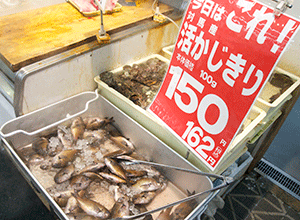
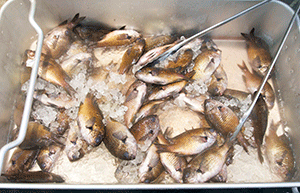
Example at a fish shop in Nagasaki prefecture
As you can see in the image above, damselfish is a small fish and is as large as 30 g to 50 g.
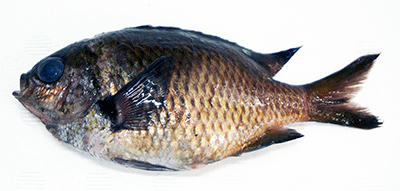
Damselfish belongs to Pomacentridae family.Chrominae subfamily Chromis genus and the areas like eating this fish likes Fukuoka and Nagasaki and Osaka, and in other parts of Japan it is not recognized as a fish to eat mostly.
However, although it is said that it likes to eat in the Fukuoka district, this has a little faulty expression, it is limited only in the vicinity of Fukuoka city among Fukuoka prefecture, and the season to eat is from May to July from 2 to 3 months For a short period of time. It is normal whether to eat once a year as a so-called seasonal poetry, especially in families who love fish.
Eat whole as it is
I think that it is unnecessary to introduce in the image the method of "roast chew (Abutecamo)" of that general way of eating, but I will write below just in case.
| Salt-grilled whole of Abutecamo (damselfish) | |
|---|---|
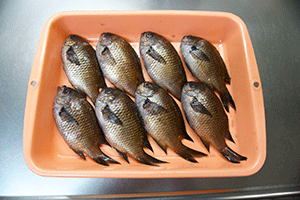 |
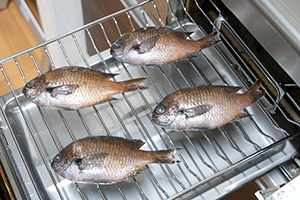 |
| 1, Wash the damselfish only with water, wipe the moisture on the surface and arrange it on the bat. | 3, Place in the grill as it is and prepare for grilling the salt. |
 |
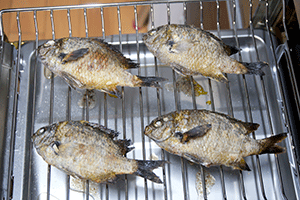 |
| 2, Shake all salt on both sides of the fish. | 4, Burn both faces at medium heat to the extent that fins will not burn in the grill. |
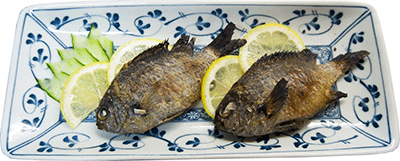 |
|
| Salt-grilled whole of Abutecamo (damselfish) is finished. | |
This whole way of how to eat the grilled salt is just biting from the head, putting it in the mouth, and eating bones and internal organs as it is. For that reason, the size is as easy to eat as possible with the smallest possible, and those who are good in that way choose to purchase a relatively small size and purchase. Unfortunately I am not good at that way, so I do a luxurious way of eating that I do not eat any head, bones or internal organs.
Damselfish from May to July has visceral fat swelling up to the abdominal cavity, and if you do eat which is not expert like the writer, you have to be prepared to realize that the actual edible portion is very few.
However, the edible portion is also fat and it is said that the moist and dense quality of density is unique taste of this time only.
Above all, the characteristic of this fish is the feeling at the time of eating scales. If the general "Guji of dried fish" and of the large natural sea bream scales fried cuisine and an exception, because it is usually not eat basically the scales of fish, I can only even a special experience that eat the scales.
More smart and delicious eating scales
In fact, I tried some experiments using damselfish from the aspect of "eating the scales" this time. And I discovered that the following way of eating is the best delicious.
| Deep-fried damselfish | |
|---|---|
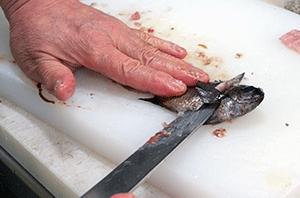 |
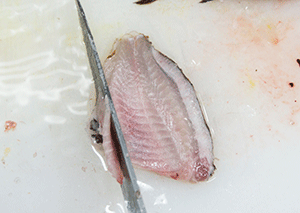 |
| 1, With the head of damselfish facing right, with the abdomen in front, with the scales attached, cut the yanagiba kitchen knife next to the breast billet. | 6, At the end of cooking, put a kitchen knife under the belly bone and remove the belly bone. |
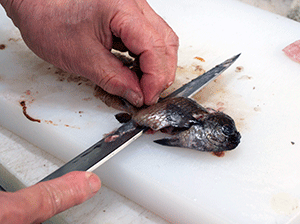 |
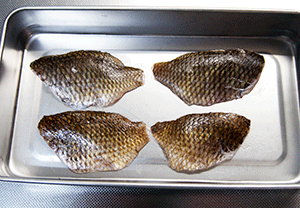 |
| 2, Move yanagiba knife as it is towards the tailbill and proceed with the method of daimyo oroshi. | 7, Wipe off the moisture of half of the body divided into three while the scales are left, put salt and pepper side by side in the container. |
 |
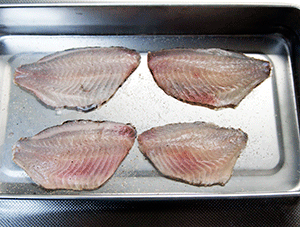 |
| 3, The state where the internal body is left as it is, the shitami is separated. | 8, Salt and pepper to the whole, including the meat, not just to the skin. |
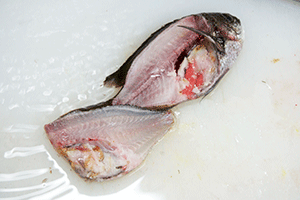 |
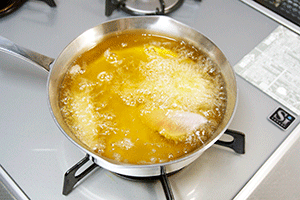 |
| 4, Detach the lower body and return the surface of the scales down. The internal organs still remain in the lower abdomen. | 9,Fry quickly for 2 minutes lightly at a temperature of 180 degrees. |
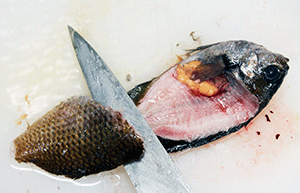 |
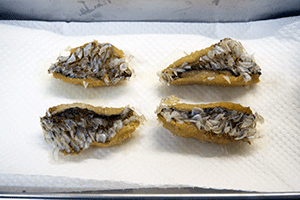 |
| 5, Next, separate the uwami on the other side in the same way as the lower body. | 10, If it is fried, the scales turn white, as if the scales get up. |
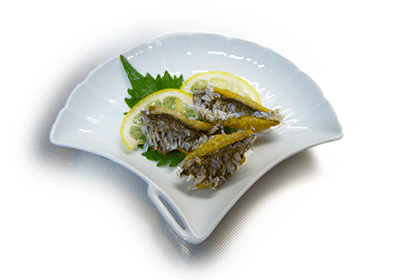 |
|
| Abutecamo (damselfish) Fried fish with scales is finished. | |
This time I tried various ways of eating damselfish, but the most popular was the deep-fried with this scalp. Despite having a small bone, it was not as bothersome as it was, but the texture of the scales felt fancy and the surface was crispy and it was able to taste the moist and fried fish's mouthfeel while it was crisp.
It is tasty even with sashimi
I've been introducing baked and fried dishes so far, but of course you can eat raw fresh raw fish so let 's introduce an easy way to do it.
| Damselfish sashimi commercialization process | |
|---|---|
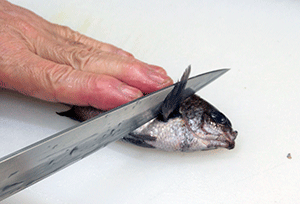 |
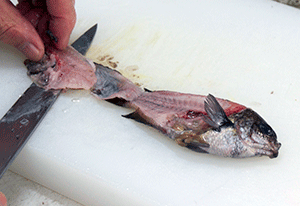 |
| 1, With the head of the damselfish facing right, with the abdomen in front, with the scales attached, make a notch with a kitchen knife next to the breast billet. | 7, Do not cut off the skin to which the scales are attached, leave the skin as it is, separate the body from the skin. |
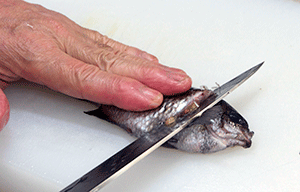 |
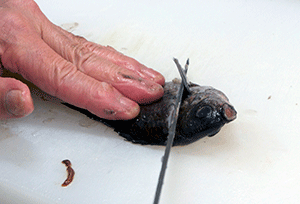 |
| 2, From the notch, slide yanagiba on the middle bone at the angle of the L shape. | 8, Also put a notch on the uwami side next to the breast billet. |
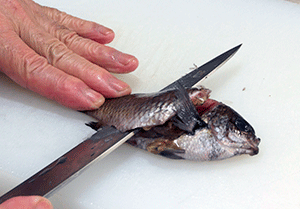 |
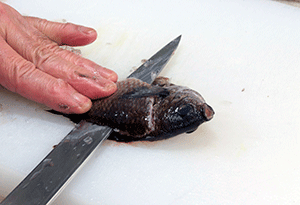 |
| 3, Move yanagiba towards the tailbill and proceed towards the tailbill by way of daimyo oroshi. | 9, Cut the yanagiba to the angle of L, and continue cutting on the middle bone as it is. |
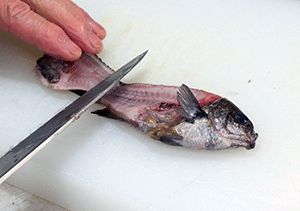 |
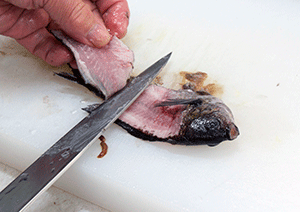 |
| 4, After cutting down to the vicinity of the tailbill, turn over the sitami without detaching it as it is. | 10, After cutting down to the vicinity of the tail end, turn uwami over without separating. |
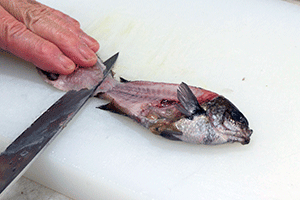 |
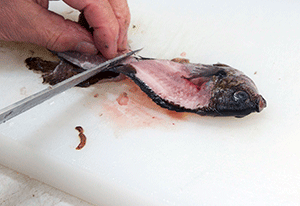 |
| 5, Cut shallowly near the bottom tailbill. | 11, Make a notch near the tailbill. |
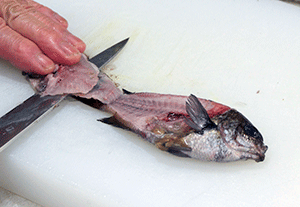 |
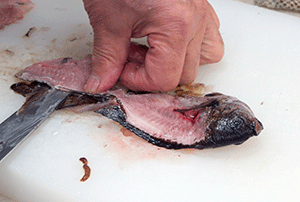 |
| 6, From the part where notch is put, while cutting the leather down, it cuts toward the head side by the method of uchibiki. | 12, Cut off as it is from notch, separate the body from the skin, remove the belly bone, lightly wash with water and wipe off moisture. |
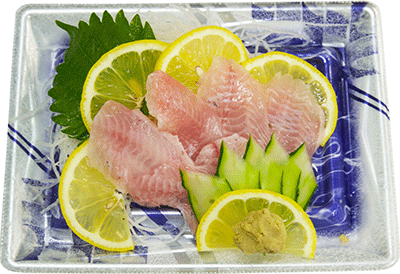 |
|
| Since damselfish is a small fish, it is commercialized as a sashimi in the shape of a half. | |
The damselfish sashimi was my first experience and I was curious about what it tastes like. For small fish bodies there is firm fat, and compared with the taste of other fish during this period, I felt that this fish was a taste of the highest rankable level.
Segoshi sashimi
On the other hand, damselfish is familiar with the name "Kajikiri", but rather people in Nagasaki prefecture Tsushima who often eat damselfish often taught that they often eat segoshi sashimi locally. So I also tried to commercialize it in the way of Ayu's segoshi as follows.
| Commercialization process of damselfish's segoshi sashimi | |
|---|---|
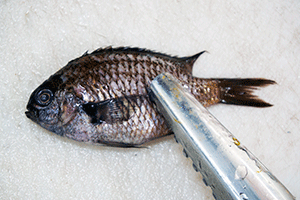 |
 |
| 1, Removing a small damselfish's scalp is troublesome and tough. | 5, The inside of the abdominal cavity of damselfish in this period has swollen to a state of bread without gaps. |
 |
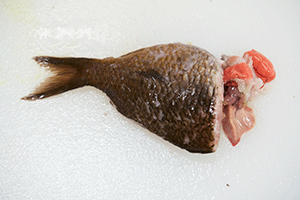 |
| 2. After removing the scales, then remove the back fins. | 6, Take out the swollen internal organs as there is no gap to put your fingers. |
 |
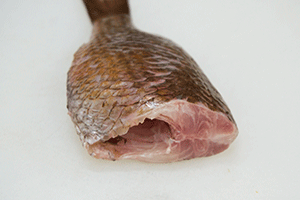 |
| 3, Buttocks bille also removed. | 7, After removing internal organs, wash it off and wipe off moisture. |
 |
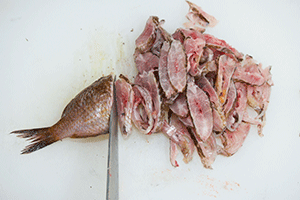 |
| 4, Remove the head while leaving the breast billet on the head. | 8, Make it as thin as possible with the yanagiba kitchen knife. |
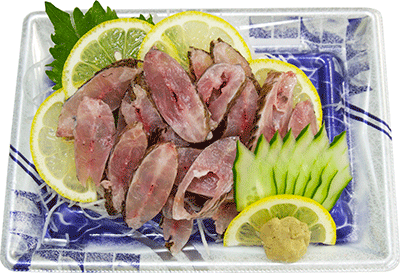 |
|
| Cool damselfish over the back with ice water, take water and serve it as a commercial product. | |
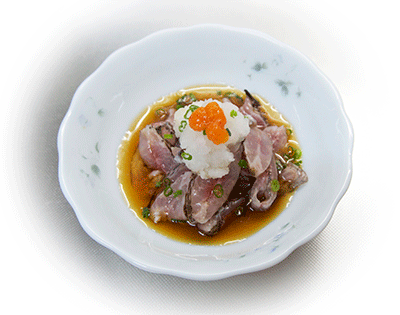 |
|
| When eating damselfish segoshi add ponzu and momizioroshi. | |
Speaking about how the taste of damselfish made to segoshi was, the first of its impressions was that "the taste is not bad but the backbone is a little too hard to eat with segoshi."
Also, the kitchen knife work when damselfish is made segoshi, because the fish body is "round and short and not stable feeling", it is hard for places to place your left hand compared to ayu and horse mackerel, there is resistance of hard spine It was hard to deal with, and in fact it felt the difficulty of being thin to segoshi 's thickness.
Although we have introduced various ways of eating sparrow ever so far, the district name of Fukuoka Abutecamo is famous for its unique fish name, and it can be said that it is a feature of early summer of Hakata. But those who prefer this is part of the Through people level, and when the season comes, it is not a fish that ordinary people fight to buy.
However, this is the fish that represents "season", it is a representative that can enjoy the deliciousness of the fish at that time, and that people in other areas will not look for the fish is "to lose by not knowing I think that it leads to.
This June is the height of damselfish in the middle of the season. Fish officials who have neither treated nor saw this fish should consult this homepage of this month and treat it once as a trial. It might be surprised by its unexpected taste.
An opinion and the communication are to iinfo@fish food times
Date of updating Jun.1. 2017
